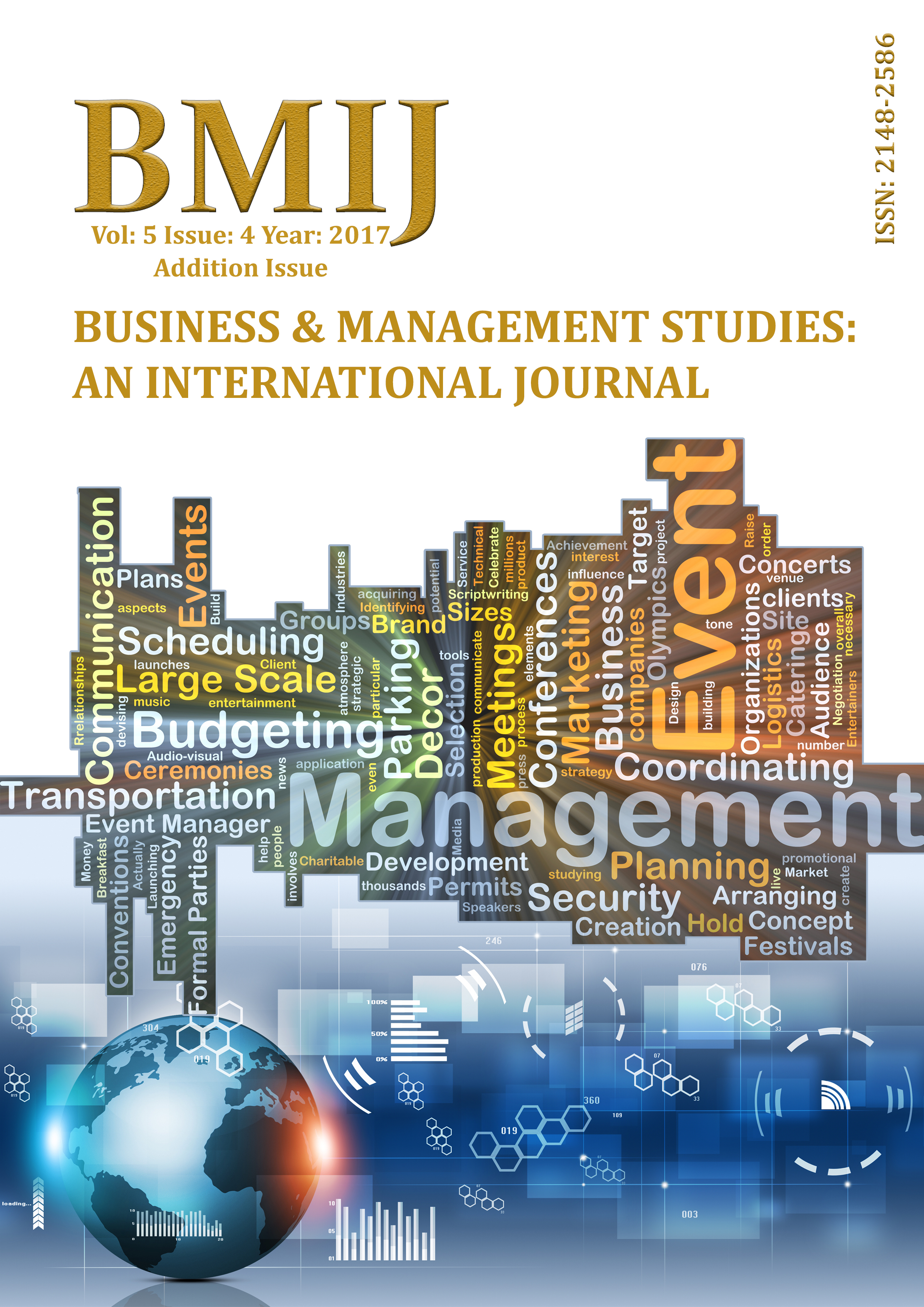
Yayınlanmış 2018-01-07
Anahtar Kelimeler
- Kâr Yönetimi,
- Yönetim Kurulu Yapısı.
Nasıl Atıf Yapılır
Özet
Bu çalışmanın amacı firmaların yönetim kurulu yapısı (bağımsız üye, denetim komitesi, kadın üye ve yönetim kurulu büyüklüğü) ve kâr yönetimi uygulamaları arasındaki ilişkinin incelenmesidir. Söz konusu ilişkinin incelenmesi amacıyla dört farklı kâr yönetimi tahmin modeli kullanılmış ve dört hipotez test edilmiştir. Çalışma kapsamında BIST İmalat Sektöründe faaliyet gösteren firmalara ait 2011 – 2016 yıllarını kapsayan veriler kullanılmıştır. Elde edilen sonuçlara göre; yönetim kurulu içindeki bağımsız üye oranının tahakkuk ve gelir manipülasyonu temelli kâr yönetimi uygulamaları ile ilişkili olduğu ve yönetim kurulundaki kadın üye oranının artmasının nakit akışı ve gelir manipülasyonu temelli kâr yönetimi uygulamalarını azalttığı görülmüştür. Yönetim kurulu büyüklüğünün artmasının da nakit akışı ve gelir manipülasyonu temelli kâr yönetimi uygulamalarını azalttığı tespit edilmiştir. Çalışma kapsamında elde edilen bulguların denetim komitesi üye oranının kâr yönetimi uygulamalarını azalttığı hipotezini desteklemediği sonucuna ulaşılmıştır.
İndirmeler
Referanslar
- Abdul Rahman, R., & Haneem Mohamed Ali, F. (2006). Board, audit committee, culture and earnings management: Malaysian evidence. Managerial Auditing Journal, 21(7), 783-804.
- Adams, R. B., Gray, S., & Nowland, J. (2010). Is there a business case for female directors? Evidence from the market reaction to all new director appointments.
- Alkdai, H. K. H., & Hanefah, M. M. (2012). Audit committee characteristics and earnings management in Malaysian Shariah-compliant companies. Business and Management Review, 2(2), 52-61.
- Arun, T. G., Almahrog, Y. E., & Aribi, Z. A. (2015). Female directors and earnings management: Evidence from UK companies. International Review of Financial Analysis, 39, 137-146.
- Aygün, M., Sayin, H. C., & Akçay, A. Ö. (2014). Yönetim Kurulu Ve Kar Yönetimi Arasindaki İlişki: Borsa İstanbul Üzerine Bir İnceleme. World of Accounting Science, 16(4).
- Beasley, M. S. (1996). An empirical analysis of the relation between the board of director composition and financial statement fraud. Accounting review, 443-465.
- Davidson, R., Goodwin‐Stewart, J., & Kent, P. (2005). Internal governance structures and earnings management. Accounting & Finance, 45(2), 241-267.
- Dechow, P. M., Sloan, R. G., & Sweeney, A. P. (1995). Detecting earnings management. Accounting review, 193-225.
- Dechow, P. M., & Dichev, I. D. (2002). The quality of accruals and earnings: The role of accrual estimation errors. The Accounting Review, 77(s-1), 35-59.
- DeFond, M. L., & Subramanyam, K. (1998). Auditor changes and discretionary accruals. Journal of accounting and economics, 25(1), 35-67.
- Fama, E. F., & Jensen, M. C. (1983). Separation of ownership and control. The Journal of Law and Economics, 26(2), 301-325.
- Francis, J. R., Maydew, E. L., & Sparks, H. C. (1999). The role of Big 6 auditors in the credible reporting of accruals. Auditing: A Journal of Practice & Theory, 18(2), 17-34.
- Gavious, I., Segev, E., & Yosef, R. (2012). Female directors and earnings management in high-technology firms. Pacific Accounting Review, 24(1), 4-32.
- Gul, F. A., Hutchinson, M., & Lai, K. M. (2013). Gender-diverse boards and properties of analyst earnings forecasts. Accounting horizons, 27(3), 511-538.
- Healy, P. M., & Wahlen, J. M. (1999). A review of the earnings management literature and its implications for standard setting. Accounting horizons, 13(4), 365-383.
- Jensen, M. C., & Meckling, W. H. (1976). Theory of the firm: Managerial behavior, agency costs and ownership structure. Journal of financial economics, 3(4), 305-360.
- Jones, J. J. (1991). Earnings management during import relief investigations. Journal of accounting research, 193-228.
- Kim, H. J., & Yoon, S. S. (2008). THE IMPACT OF CORPORATE GOVERNANCE ON EARNINGS MANAGEMENT IN KOREA. Malaysian Accounting Review, 7(1).
- Krishnan, G. V. (2003). Audit quality and the pricing of discretionary accruals. Auditing: A Journal of Practice & Theory, 22(1), 109-126.
- McNichols, M. (2002). Discussion of the quality of accruals and earnings: multiples. Journal of accounting research, 40(1), 135-172.
- Peasnell, K. V., Pope, P. F., & Young, S. (2005). Board monitoring and earnings management: Do outside directors influence abnormal accruals? Journal of Business Finance & Accounting, 32(7‐8), 1311-1346.
- Peni, E., & Vähämaa, S. (2010). Female executives and earnings management. Managerial Finance, 36(7), 629-645.
- Srinidhi, B., Gul, F. A., & Tsui, J. (2011). Female directors and earnings quality. Contemporary Accounting Research, 28(5), 1610-1644.
- Stubben, S. R. (2010). Discretionary revenues as a measure of earnings management. The accounting review, 85(2), 695-717.
- Sun, J., Liu, G., & Lan, G. (2011). Does female directorship on independent audit committees constrain earnings management? Journal of Business Ethics, 99(3), 369-382.
- Vafeas, N. (2005). Audit committees, boards, and the quality of reported earnings. Contemporary Accounting Research, 22(4), 1093-1122.
- Xie, B., Davidson, W. N., & DaDalt, P. J. (2003). Earnings management and corporate governance: the role of the board and the audit committee. Journal of corporate finance, 9(3), 295-316.
- Ye, K., Zhang, R., & Rezaee, Z. (2010). Does top executive gender diversity affect earnings quality? A large sample analysis of Chinese listed firms. Advances in Accounting, 26(1), 47-54.
- http://kgk.gov.tr/Portalv2Uploads/files/DynamicContentFiles/T%C3%BCrkiye%20Muhasebe%20Standartlar%C4%B1/TMSTFRS2016Seti/F_R_I_K_C(1).pdf (Erişim 12.09.2017)
- http://www.resmigazete.gov.tr/eskiler/2011/12/20111230-14.htm (Erişim 15.09.2017)

